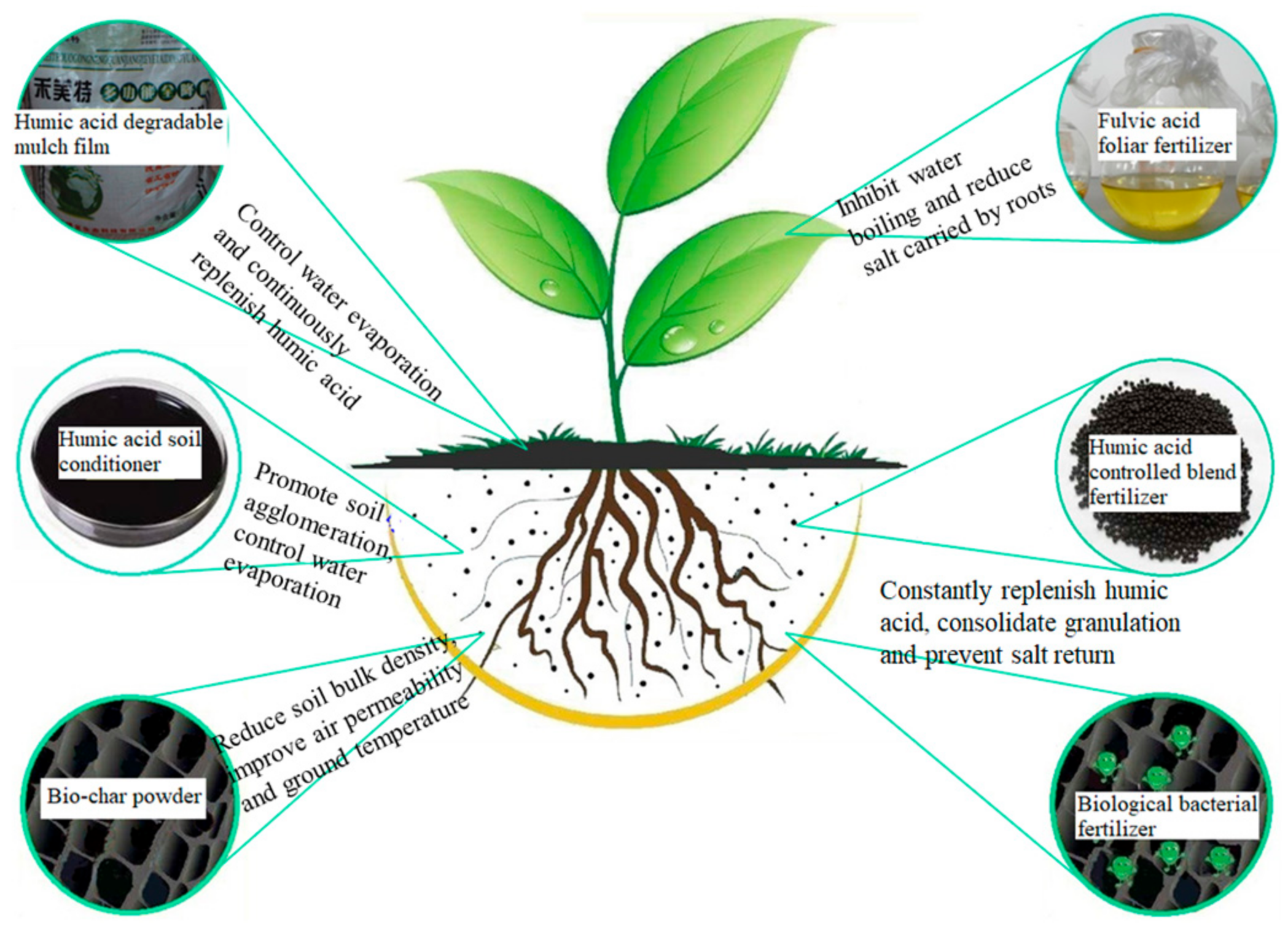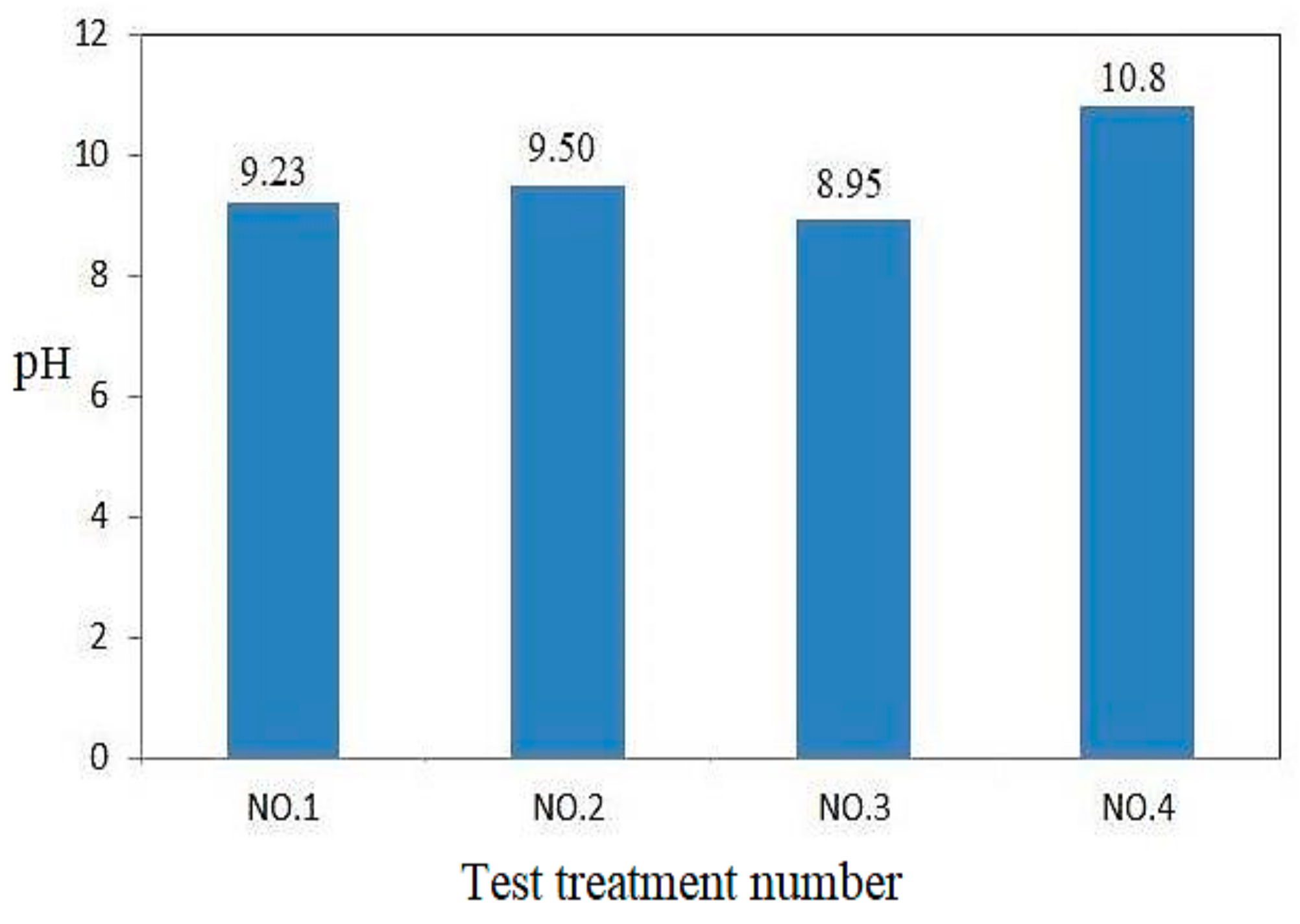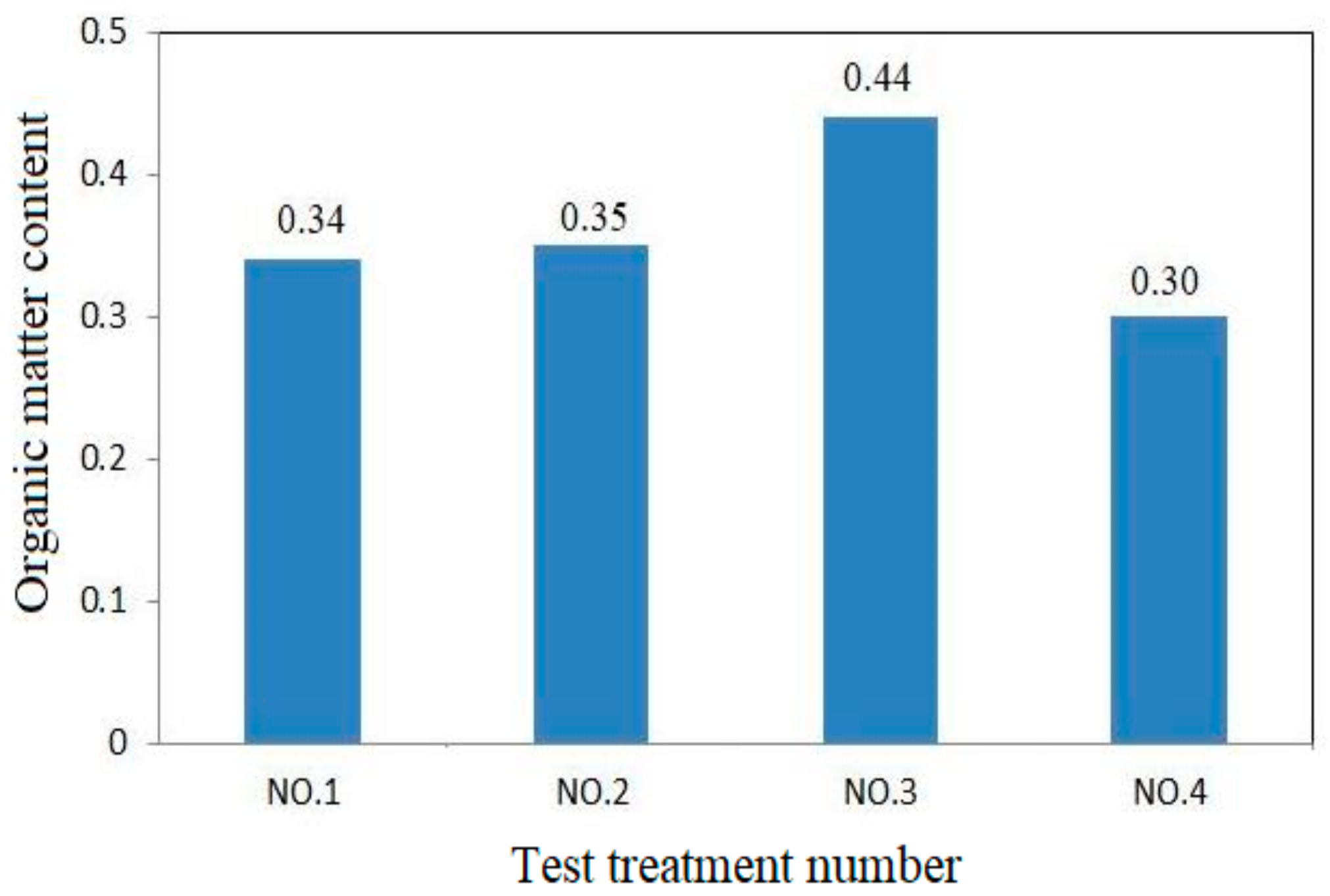Practice of Improving Saline–Alkali Soil with Bio-Humic Acid
Abstract
1. Introduction
2. Material and Methods
2.1. Test Materials
2.2. Test Treatment Number
2.3. Field Management
- ①
- Shallow water irrigation in rice cultivation mainly refers to the method of watering rice with a small amount of water after transplanting, which can replenish water for rice seedlings. Shallow water irrigation depth should generally be controlled at about 50% of the height of rice seedlings, and the maximum irrigation amount should not exceed 70% of the height of rice seedlings.
- ②
- From tillering stage to early stage of panicle differentiation of rice, it is necessary to remove all the water in the paddy field and dry the field.
- ③
- In order to ensure the stable yield and quality of rice, attention should be paid to the application of nitrogen, phosphorus, potassium, and other fertilizers, as well as the appropriate application of trace elements.
- ④
- All of the types of weeds and injurious insects in the field will compete for nutrients with rice and destory photosynthesis, which is not conducive to a stable yield of rice nor to quality growth of rice. In this section, mechanical weeding and pesticides were used.
2.4. Crop Yield
3. Results and Discussion
3.1. Rice Yield before and after Improvement
3.2. Physical and Chemical Properties of Soil before and after Improvement
3.2.1. Changes in Soil Aggregate Structure before and after Soil Improvement
3.2.2. Changes in pH and Organic Matter after Soil Improvement
3.2.3. Changes in Calcium, Magnesium, and Trace Elements after soil Remediation
4. Conclusions
Author Contributions
Funding
Data Availability Statement
Conflicts of Interest
References
- Zhang, J.F.; Zhang, X.D.; Zhou, J.X.; Liu, G.H.; Li, D.X. World resources of saline soil and main amelioration measures. Res. Soil Water Conserv. 2005, 12, 28–30. [Google Scholar]
- Tian, Y.L.; Liu, Y.S.; Zhang, H.B. Discussion of saline-alkali soil improvement technology and humic acid applied technology. Humic. Acid. 2018, 3, 42–46. [Google Scholar]
- Zhang, L.; Zhai, Y.B.; Wu, C.Y.; Huang, S.; Zhang, Z. Modeling the interaction between a new four-bar subsoiling mechanism and red soil using the improved differential evolution algorithm and DEM. Comput. Electron. Agric. 2023, 208, 107783. [Google Scholar] [CrossRef]
- He, H.S.; Wang, W.J.; Zhu, H.; Yuangang, Z.; Zhonghua, Z.; Yu, G.; Huinan, X.; Xingyang, Y. Influences on the seed germination and growth with addition of kriliums in saline-alkali soil. Acta Ecol. Sin. 2008, 11, 5338–5346. [Google Scholar]
- Hao, Y.G.; Wang, S.J.; Li, Y.; Zhuo, Y.; Liu, J. Effects of straw layer and flue gas desulfurization gypsum treatments on soil salinity and sodicity in relation to sunflower yield. Geoderma 2019, 352, 13–21. [Google Scholar]
- Fei, C.; Zhang, S.R.; Zhang, L.; Ding, X. Straw is more effective than biochar in mobilizing soil organic phosphorus mineralization in saline-alkali paddy soil. Appl. Soil Ecol. 2023, 186, 104848. [Google Scholar] [CrossRef]
- Zhou, L.X.; Liu, W.; Duan, H.J.; Li, J.; Zhang, S.; Zhang, J.; Ding, S.; Xu, T.; Guo, B. Improved effects of combined application of nitrogen-fixing bacteria Azotobacter beijerinckii and microalgae Chlorella pyrenoidosa on wheat growth and saline-alkali soil quality. Chemosphere 2023, 313, 137409. [Google Scholar] [CrossRef]
- Xia, G.H.; Guo, Q.X.; Lu, Q.M.; Du, Y.; Kang, Q. Soil nutrients and ecological stoichiometric characteristics under different land use patterns in loess hilly region. Bull. Soil Water Conserv. 2020, 40, 140–147+153. [Google Scholar]
- Wu, Y.N.; Dong, H.R.; Tang, L.; Li, L.; Wang, Y.; Ning, Q.; Wang, B.; Zeng, G. Influence of humic acid and its different molecular weight fractions on sedimentation of nanoscale zero-valent iron. Environ. Sci. Pollut. Res. 2020, 27, 2786–2796. [Google Scholar] [CrossRef] [PubMed]
- Sun, Z.J. Research on Effects and the Mechanism of Desulfurization Gypsum and Humic Acid on Coastal Saline-Alkali Soil Improvement; China University of Mining & Technology-Beijing: Beijing, China, 2013. [Google Scholar]
- Wang, G.L.; Lu, W.J.; Zhou, W.S.; Song, C.Y.; Liu, N.S.; E, W.S. The Invention Relates to a Sampler for Soil Detection before Planting in Saline-Alkali Land and Sampling Method. Heilongjiang Province. Patent CN112504733A, 16 March 2021. [Google Scholar]
- Wang, F.Y.; Wang, C.; Liu, Q.Q.; Jin, S.J.; Xie, Y.J. Improved effect of humic acid, earthworm protein fertilizer and vermicompost on coastal saline soils. J. China Agric. Univ. 2015, 20, 89–94. [Google Scholar] [CrossRef]
- Chen, X.R.; Ma, M.L.; Zhou, S.M.; Hu, M.; Zhai, K.; Wei, S. Effect of initial conditions on the pore structure and bimodal soil–water characteristic curve of compacted granite residual soil. Processes 2024, 12, 409. [Google Scholar] [CrossRef]
- Yang, X.Y.; Zhang, Y.M.; Chen, F.M.; Yang, Y. Interplay of natural organic matter with flow rate and particle size on colloid transport: Experimentation, visualization, and modeling. Environ. Sci. Technol. 2015, 49, 13385–13393. [Google Scholar] [CrossRef] [PubMed]
- Liang, B.; Xie, Y.Y.; Fang, Z.Q.; Tsang, E.P. Assessment of the transport of polyvinylpyrrolidone-stabilised zero-valent iron nanoparticles in a silica sand medium. J. Nanoparticle Res. 2014, 16, 2485. [Google Scholar] [CrossRef]









| Test No. | Effective Panicles/Hole | KNE a | TGW b | Output kg | 20 Hole Fresh Grain Weight, kg | 20 Hole Dry Grain Weight, kg | Equivalent Yield kg/ha |
|---|---|---|---|---|---|---|---|
| No. 1 | 22 | 97.5 | 22 | 0.602 | 0.928 | 0.795 | 8947.5 |
| No. 2 | 23 | 115.6 | 22 | 0.746 | 1.129 | 0.879 | 9885.0 |
| No. 3 | 22.3 | 98.4 | 22 | 0.616 | 0.878 | 0.760 | 8551.5 |
| No. 4 | 4 | 25.0 | 22 | 0.028 | 0.041 | 0.035 | 393.0 |
Disclaimer/Publisher’s Note: The statements, opinions and data contained in all publications are solely those of the individual author(s) and contributor(s) and not of MDPI and/or the editor(s). MDPI and/or the editor(s) disclaim responsibility for any injury to people or property resulting from any ideas, methods, instructions or products referred to in the content. |
© 2024 by the authors. Licensee MDPI, Basel, Switzerland. This article is an open access article distributed under the terms and conditions of the Creative Commons Attribution (CC BY) license (https://creativecommons.org/licenses/by/4.0/).
Share and Cite
Zhang, C.; Qiao, Y.; Song, Q. Practice of Improving Saline–Alkali Soil with Bio-Humic Acid. Processes 2024, 12, 1250. https://doi.org/10.3390/pr12061250
Zhang C, Qiao Y, Song Q. Practice of Improving Saline–Alkali Soil with Bio-Humic Acid. Processes. 2024; 12(6):1250. https://doi.org/10.3390/pr12061250
Chicago/Turabian StyleZhang, Chuyan, Yingyun Qiao, and Qiang Song. 2024. "Practice of Improving Saline–Alkali Soil with Bio-Humic Acid" Processes 12, no. 6: 1250. https://doi.org/10.3390/pr12061250
APA StyleZhang, C., Qiao, Y., & Song, Q. (2024). Practice of Improving Saline–Alkali Soil with Bio-Humic Acid. Processes, 12(6), 1250. https://doi.org/10.3390/pr12061250






